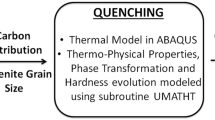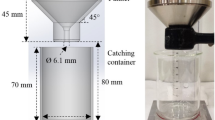A multiobjective surrogate-based inverse modeling technique to predict the spatial and temporal pressure distribution numerically during the fabrication of sheet moulding compounds (SMCs) is introduced. Specifically, an isotropic temperature-dependent Newtonian viscosity model of a SMC charge is fitted to experimental measurements via numerical simulations in order to mimic the temporal pressure distribution at two spatial locations simultaneously. The simulations are performed by using the commercial computational fluid dynamics (CFD) code ANSYS CFX-10.0, and the multiobjective surrogate-based fitting procedure proposed is carried out with a hybrid formulation of the NSGA-IIa evolutionary algorithm and the response surface methodology in Matlab. The outcome of the analysis shows the ability of the optimization framework to efficiently reduce the total computational load of the problem. Furthermore, the viscosity model assumed seems to be able to re solve the temporal pressure distribution and the advancing flow front accurately, which can not be said of the spatial pressure distribution. Hence, it is recommended to improve the CFD model proposed in order to better capture the true behaviour of the mould flow.
Similar content being viewed by others
References
H. G. Kia, Sheet Moulding Compounds: Science and Technology, Hanser Verlag, Munich (1993).
P. T. Odenberger, H. M. Andersson, and T. S. Lundström, ”Experimental flow-front visualization in compression moulding of SMC,” Composites, Pt. A, 35, No. 10, 1125-1134 (2004).
T. S. Lundström, “Bubble transport through constricted capillary tube with application to resin transfer moulding,” Polym. Compos., 17, 770-779 (1996).
T. S. Lundström, “Measurement of void collapse during resin transfer moulding,” Composites, Pt. A, 28, 201-214 (1997).
M. R. Barone and D. A. Caulk, “Kinematics of flow in sheet moulding compounds,” Polym. Compos., 6, No. 2, 105-109 (1985).
T. A. Osswald and C. L. Tucker, “Compression mold filling simulation for non-planar parts,” Int. Polym. Proc., 2, 79-87 (1990).
P. K. Mallick, “Compression molding,” in: P. K. Mallick and S. Newman (eds.), Composite Materials Technology —Processes and Properties, Hanser Publishers, Munich–Vienna–New York (1990), pp. 67-102.
T. A. Osswald and S.-C. Tseng, ”Compression molding,” in: S. G. Advani (ed.), Flow and Rheology in Polymer Com osites Manufacturing, Composite Materials Series. Vol. 10, Elsevier (1994), pp. 361-413.
W. Michaeli, M. Mahlke, T. A. Osswald, and M. N. Nölke, ”Simulation of the flow in SMC,” Kunstst. Germ. Plast., 80, No. 6, 31-33 (1990).
P. T. Odenberger and T. S. Lundström, “Inverse modelling of compression moulding of SMC with us age of computational fluid dynamics,” in: Proc. ICCM-15 Conf., Durban, South Africa, June 27-July 1 (2005).
B. D. Marjavaara, T. S. Lundström, T. Goel, Y. Mack, and W. Shyy, “Hydraulic turbine diffuser shape optimization by multiple surrogate model approximations of Pareto fronts,” J. Fluids Eng., 129, No. 9, 1228-1240.
N. V. Queipo, R. T. Haftka, W. Shyy, T. Goel, R. Vaidyanathan, and P. K. Tucker, “Surrogate-based analysis and optimization,” Prog. Aerosp. Sci., 41, No. 1, 1-28 (2005).
H. A. Barnes, J. F. Hutton, and K. Walters, An Introduction to Rheology, Elsevier, Amsterdam (1989).
C. C. Lee and C. L. Tucker, “Flow and heat transfer in compression mold filling,” J. Non-New ton. Fluid Mech., 24, No. 3, 245-264 (1987).
A. Tarantola, Inverse Problem Theory, Elsevier, Amsterdam (1987).
I. B. Celik and O. Karatekin, “Numerical experiments on application of Richard son extrapolation with non uniform grids,” J. Fluids Eng., 119, No. 3, 584-590 (1997).
Matlab. The Language of Technical Computing, Version 7.0.1. The MathWorks, Inc. Natick, MA (2004).
CFX, CFX-5, Version 10.0. ANSYS Europe Ltd., Riseley, UK (2005).
T. Goel, R. Vaidyanathan, R. T. Haftka, N. V. Queipo, W. Shyy, and P. K. Tucker, “Response surface approximation of Pareto opt mal front in multi-objective optimization,” Comput. Meth. Appl. Mech., 196, No. 4, 879-893 (2004).
Author information
Authors and Affiliations
Corresponding author
Additional information
Russian translation published in Mekhanika Kompozitnykh Materialov, Vol. 45, No. 5, pp. 721-738, September-October, 2009.
Rights and permissions
About this article
Cite this article
Marjavaara, B.D., Ebermark, S. & Lundström, T.S. Compression moulding simulations of SMC using a multiobjective surrogate-based inverse modeling approach. Mech Compos Mater 45, 503–514 (2009). https://doi.org/10.1007/s11029-009-9109-2
Received:
Revised:
Published:
Issue Date:
DOI: https://doi.org/10.1007/s11029-009-9109-2




